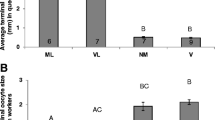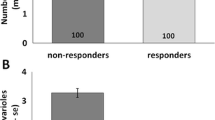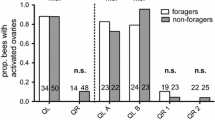Abstract
How individual organisms whose behavior is potentially driven by selfish interests cooperate to form a society is a central question in evolutionary biology. Worker reproduction and its suppression in eusocial insects provide an illuminating model of such a conflict resolution. Although many theoretical and empirical studies focus on the nature and evolutionary consequences of this reproductive conflict, little is known about its physiological underpinnings. Here, we hypothesized that the dopaminergic system, which has a gonadotropic function in eusocial Hymenoptera, is controlled by social suppression via the queen presence signal and the worker-worker dominance interactions. In Diacamma sp. from Japan, the queen presence signal is transferred to workers by direct contact, and worker-worker dominance interaction occurs commonly in large colonies, even when a queen is present. Using the ant Diacamma sp., we showed that the aggressive interactions among workers suppressed brain dopamine levels of the workers. Moreover, our data suggest that the queen presence signal transmitted by direct contact suppresses the brain dopamine level and the transcription of dopamine synthetic enzyme (ddc) of workers. Our data provide clear empirical evidence that worker brain dopamine is suppressed by both social stimuli directed from dominant workers and the queen.
Significance statement
In eusocial Hymenoptera, worker reproduction is suppressed by social interactions such as queen presence information and dominance interaction. Dopamine, one of the biogenic amines, is a well-known gonadotropic neurohormone in eusocial Hymenoptera. Honeybee studies revealed that the queen presence information regulated dopamine levels in worker brains. In an ant, the dominance interaction also controlled dopamine levels of workers. In a queenless ant Diacamma sp., queen presence information and dominance interaction are known to dually suppress worker reproduction. Given the above examples, dopaminergic signaling is predicted to be a general mechanism that can suppress worker reproduction in multiple ways. We here test whether both the queen- and worker-originated signals (i.e., queen presence information and dominance interaction) affect the worker dopamine level. We show that dopaminergic signaling is affected by dual social factors, suggesting the general role of dopaminergic signaling in mediating social interaction and reproductive suppression.





Similar content being viewed by others
References
Adamo SA, Linn CE, Hoy RR (1995) The role of neurohormonal octopamine during fight or flight behaviour in the field cricket Gryllus bimaculatus. J Exp Biol 198:1691–1700
Baier A, Wittek B, Brembs B (2002) Drosophila as a new model organism for the neurobiology of aggression? J Exp Biol 205:1233–1240
Beggs KT, Mercer AR (2009) Dopamine receptor activation by honey bee queen pheromone. Curr Biol 19:1206–1209
Beggs KT, Glendining KA, Marechal NM, Vergoz V, Nakamura I, Slessor KN, Mercer AR (2007) Queen pheromone modulates brain dopamine function in worker honey bees. Proc Natl Acad Soc USA 104:2460–2464
Bloch G, Simon T, Robinson GE, Hefetz A (2000) Brain biogenic amines and reproductive dominance in bumble bees (Bombus terrestris). J Comp Physiol A 186:261–268
Bloch G, Shpigler H, Wheeler DE, Robinson GE (2009) Endocrine influences on the organization of insect societies. In: Pfaff DW, Arnold PA, Etgen AM, Se F, Rubin RT (eds) Hormones, brain and behavior, 2nd edn. Academic Press, San Diego, pp 1027–1068
Bourke AFG (2011) Principles of social evolution. Oxford University Press, Oxford
Bourke AFG, Franks NR (1995) Social evolution in ants. Princeton University Press, Princeton
Bubak AN, Grace JL, Watt MJ, Renner KJ, Swallow JG (2014) Neurochemistry as a bridge between morphology and behavior: perspectives on aggression in insects. Curr Zool 60:778–790
Buschinger A (1987) Polymorphism and reproductive division of labor in advanced ants. In: Eder J, Rembold H (eds) Chemistry and biology of social insects. Verlag J. Peperny, Munich, pp 257–258
Cant MA (2012) Cooperative breeding system. In: Royle NJ, Smiseth RT, Kölliker M (eds) The evolution of parental care. Oxford University Press, Oxford, pp 206–225
Cuvillier-Hot V, Lenoir A (2006) Biogenic amine levels, reproduction and social dominance in the queenless ant Streblognathus peetersi. Sci Nat 93:149–153
Dombroski TCD, Simões ZLP, Bitondi MMG (2003) Dietary dopamine cases ovary activation in queenless Apis mellifera workers. Apidologie 34:281–290
Fletcher DJC, Ross KG (1985) Regulation of reproductive in eusocial hymenoptera. Annu Rev Entomol 30:319–343
Fukumoto Y, Abe T, Taki A (1989) A novel form of colony organization in the ‘queenless’ ant Diacamma rugosum. Physiol Ecol Jpn 26:55–61
Harris JW, Woodring J (1995) Elevated brain dopamine levels associated with ovary development in queenless worker honey bees (Apis mellifera L.). Comp Biochem Physiol C Pharmacol Toxicol Endocrinol 111:271–279
Hartfelder K, Emlen DJ (2012) Endocrine control of insect polyphenism. In: Gilbert LI (ed) Insect endocrinology. Academic Press, San Diego, pp 464–522
Kamhi JF, Traniello JFA (2013) Biogenic amines and collective Organization in a Superorganism: neuromodulation of social behavior in ants. Brain Behav Evol 82:220–236
Kamhi JF, Nunn K, Robson SK, Traniello JFA (2015) Polymorphism and division of labour in a socially complex ant: neuromodulation of aggression in the Australian weaver ant, Oecophylla smaragdina. Proc R Soc B 282:20150704
Keller L, Nonacs P (1993) The role of queen pheromones in social insects: queen control or queen signal? Anim Behav 45:787–794
Kikuchi T, Nakagawa T, Tsuji K (2008) Changes in relative importance of multiple social regulatory forces with colony size in the ant Diacamma sp. from Japan. Anim Behav 76:2069–2077
Kikuchi T, Suwabe M, Tsuji K (2010) Durability of information concerning the presence of a gamergate in Diacamma sp. from Japan. Physiol Entomol 35:93–97
Kravitz EA, Huber R (2003) Aggression in invertebrates. Curr Opin Neurobiol 13:763–743
Le Conte Y, Hefetz A (2008) Primer pheromones in social hymenoptera. Annu Rev Entomol 53:523–542
Libersat F, Pflueger HJ (2004) Monoamines and the orchestration of behavior. Bioscience 54:17–25
Maynard Smith J, Szathmáry E (1995) The major transitions in evolution. Oxford University Press, Oxford
Nakata K (1995) Age polyethism, idiosyncrasy and behavioural flexibility in the queenless ponerine ant, Diacamma sp. J Ethol 13:113–123
Nakata K, Tsuji K (1996) The effect of colony size on conflict over male-production between gameragte and dominant workers in the ponerine ant Diacamma sp. Ethol Ecol Evol 8:147–156
Neckameyer WS (1996) Multiple roles for dopamine in Drosophila development. Dev Biol 176:209–219
Nelson RJ (2006) Biology of aggression. Oxford University Press, Oxford
Okada Y, Miyazaki S, Miyakawa H, Ishikawa A, Tsuji K, Miura T (2010) Ovarian development and insulin-signaling pathways during reproductive differentiation in the queenless ponerine ant Diacamma sp. J Ins Physiol 56:288–295
Okada Y, Sasaki K, Miyazaki M, Shimoji H, Tsuji K, Miura T (2015) Social dominance and reproductive differentiation mediated by the dopaminergic signaling in a queenless ant. J Exp Biol 218:1091–1098
Pastor D, Piulachs MD, Cassier P, André M, Bellés X (1991) Etude in vivo et in vitro de l’action de la dopamine sur la croissance des ovocytes et la production d’hormone juvenile chez Blattella germanica (L.) (Dictyoptera; Blattellidae). C R Acad Sci III 313:207–212
Peeters C, Crewe R (1984) Insemination controls the reproductive division of labour in a ponerine ant. Sci Nat 71:50–51
Peeters C, Crozier RH (1988) Caste and reproduction in ants: not all mated egg-layers are “queens”. Psyche 95:283–288
Peeters C, Higashi S (1989) Reproductive dominance controlled by mutilation in the queenless ant Diacamma austral. Sci Nat 76:177–180
Peeters C, Tsuji K (1993) Reproductive conflict among ant workers in Diacamma sp. from Japan: dominance and oviposition in the absence of the gamergate. Ins Soc 40:119–136
Penick CA, Brent CS, Dolezal K, Liebig J (2014) Neurohormonal changes associated with ritualized combat and the formation of a reproductive hierarchy in the ant Harpegnathos saltator. J Exp Biol 217:1496–1503
Ratnieks FLR, Foster KR, Wenseleers T (2006) Conflict resolution in insect societies. Annu Rev Entomol 51:581–608
Sasaki K, Yamasaki K, Nagao T (2007) Neuro-endocrine correlates of ovarian development and egg-laying behaviors in the primitively eusocial wasp (Polistes chinensis). J Ins Physiol 53:940–949
Sasaki K, Yamasaki K, Tsuchida K, Nagao T (2009) Gonadotropic effects of dopamine in isolated workers of the primitively eusocial wasp, Polistes chinensis. Sci Nat 96:625–629
Sasaki K, Matsuyama S, Harano K, Nagao T (2012) Caste differences in dopamine-related substances and dopamine supply in the brains of honeybees (Apis mellifera L.). Gen Comp Endocrinol 178:46–53
Schultz DJ, Robinson GE (1999) Biogenic amines and division of labor in honey bee colonies: behaviorally related changes in the antennal loves and age-related changes in the mushroom bodies. J Comp Physiol A 184:481–488
Shimoji H, Fujiki Y, Tsuji K, Yamaoka R (2011) Do eggs convey information on gamergate presence in Diacamma sp. from Japan? Ins Soc 58:3–7
Shimoji H, Abe MS, Tsuji K, Masuda N (2014) Global network structure of dominance hierarchy of ant workers. J Roy Soc Interface 11:20140599
Smith AR, Muscedere ML, Seid MA, Traniello JFA, Hughes OH (2013) Biogenic amines are associated with worker task but not patriline in the leaf-cutting ant Acromyrmex echinatior. J Comp Physiol A 199:1117–1127
Tsuji K, Egashira K, Hölldobler B (1999) Regulation of worker reproduction by direct physical contact in the ant Diacamma sp. from Japan. Anim Behav 58:337–343
Vander Meer RK, Preston CA, Hefetz A (2008) Queen regulates biogenic amine level and nestmate recognitions in workers of the fire ant, Solenopsis invicta. Sci Nat 95:1155–1158
West SA, Griffin AS, Gardner A (2007) Evolutionary explanations for cooperation. Curr Biol 17:R661–R672
Acknowledgements
We are grateful to Devin, O’Brian for editing an early version of this manuscript. We thank Takashi Watanabe for the discussion and Haruki Tatsuta and Chifune Sasa for the ant collection. We also thank Yasuhiro Sugime, Run Minoura, and Kohei Oguchi for the molecular analyses and Masahito Kimura for the experimental setup. We also thank Alison Mercer and two anonymous referees for comments on an earlier draft. This work was supported by Grant-in-Aid for JSPS Fellows (no. 13J04279 to HS), KAKENHI (no. 23300113 to HA; nos. 26249024, 25660266, 25304014, 23405011, 15H04425, 15H02652 to KT; nos. 25251041, 2525104 to MT; no. 26440181 to KS; no.26870121 to YO).
Author information
Authors and Affiliations
Corresponding authors
Additional information
Communicated by W. Hughes
Electronic supplementary material
ESM 1
(DOCX 986 kb)
Rights and permissions
About this article
Cite this article
Shimoji, H., Aonuma, H., Miura, T. et al. Queen contact and among-worker interactions dually suppress worker brain dopamine as a potential regulator of reproduction in an ant. Behav Ecol Sociobiol 71, 35 (2017). https://doi.org/10.1007/s00265-016-2263-3
Received:
Revised:
Accepted:
Published:
DOI: https://doi.org/10.1007/s00265-016-2263-3




